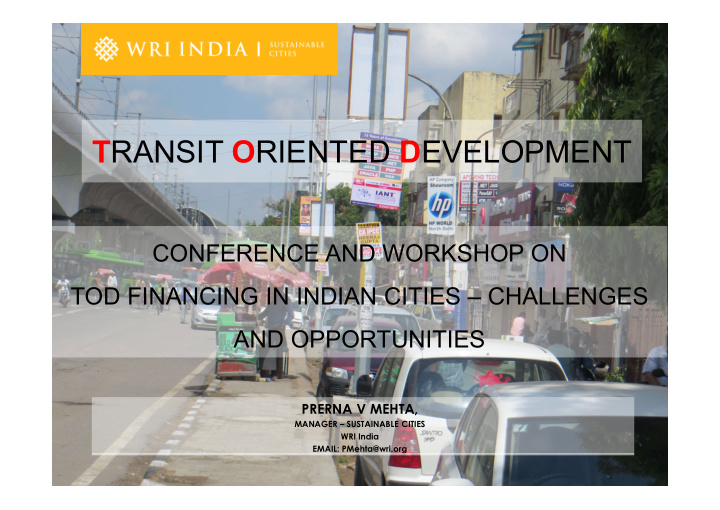



T RANSIT O RIENTED D EVELOPMENT CLICK TO EDIT MASTER TITLE CONFERENCE AND WORKSHOP ON TOD FINANCING IN INDIAN CITIES – CHALLENGES STYLE AND OPPORTUNITIES Click to edit Master text styles PRERNA V MEHTA, MANAGER – SUSTAINABLE CITIES AUTHOR NAMES GO HERE, AUTHOR NAME, AUTHOR NAME WRI India EMAIL: PMehta@wri.org
TOD Concept “Moderate and high-density housing, along with complementary public uses, jobs, retails and services, are concentrated in mixed-use developments at strategic points along the regional transit system.” - Peter Calthorpe, The Next American Metropolis, 1993
What is TOD? TOD is essentially any development, macro or micro that is focused around a transit node , and facilitates complete ease of access to the transit facility , thereby inducing people to prefer to walk and use public transportation over personal modes of transport. (MPD-2021).
TOD Principals High Density, Mixed-use, Mixed-Income Development near stations Pedestrian & Non- Multi-Modal Interchange and Motorized Transport (NMT) Inducing Modal Shift Friendly Environment (Public Transport, cycling & (Walking & bicycling) pedestrian priority) Place making and Ensuring Connectivity and Network Safety Density (Active edges & Public spaces) (Travel Demand Management)
Why TOD for India?
10+ cities are opting for metro rail. 7+ opting for BRT. Existing policy frameworks recognizes TOD as key development tool e.g. statutory documents like Master Plans e.g. MPD-2021, Ahmedabad Master Plan, NUTP mandates Integrated land use and transport planning, national level guidelines like URDPFI guideline 2014.
Increase in Urban Footprint of Bangalore (1990 to 2015) 1990 2000 2010 2015 Image Data Source: Global Land Survey and LandSat (USGS), Open Streets Map, NHAI, BBMP, BDA
Increase in Urban Footprint of Bangalore (2005 - 06 to 2011-12) • Increase in urban area from 2006 to 12 for Bangalore • Map indicates an increase of 13 sqkms / year in the municipal area • 29 sq kms/year in the development authority area • 60 sq kms / year in the regional authority area Source: Land Use and Land Cover (50K) 2005-06 - 2011-12, NRSC – ISRO, BBMP, BMRDA
Global TOD models
Co-development model to begin with, focused on leveraging real estate around transit to create funds for development. Image Courtesy: Design for Health, Flickr stream
How does R+P model work MTRC confers MTRC + State property Profit sharing Agreement rights Construction cost MTRC has design Profit sharing • • • assessments + construction between all Land premium oversight parties – • negotiated Developers pay MTRC / State / • • Project land premium + Developers • sanctioned development Tender costs • development Project • construction
Chicago Transit Planning Regional Authorities Regional Transit Authority Chicago Metropolitan Agency for Planning Functions Planning and oversight of mass Comprehensive regional transit* (and operation of some planning since 2006, looking at lines) issues including land use and Supports TOD related plans + transport integration, housing, funding such programs in the economic development etc. Chicago region since 1998 Provides funding** for a variety Can create a regional of projects in stations areas development vision and has under its Community Planning authority on the distribution of Program initiative, including federal funds. There has been TOD studies for communities, an increased focus on TOD zoning code updates, master and linked transit, housing and planning for station areas etc land use Notes * CTA (bus+ elevated rail+ subway)/ Metra (Commuter suburban rail) / Pace (paratransit+ bus) ** RTA guidelines on TOD, zoning etc cannot be enforced by RTA on communities
Portland State of Oregon Regional Agencies Metro Tri-Met (Metropolitan planning (Regional transit agency) agency) Funding between agencies Regional Growth TOD Tax and Fee Exemptions Urban Growth Boundary Management, 1994 (UGB), 1979 Transportation Planning Rule, 1991 followed by “2040 Growth Concept” Transportation & Growth Management Program, 1993 TOD Tax Exemption, 1995
Questions How to remove barriers and mainstream TOD? How to ensure equitable and inclusive TOD? How to utilize land value capture and other financing mechanisms to enable TOD?
Recommend
More recommend